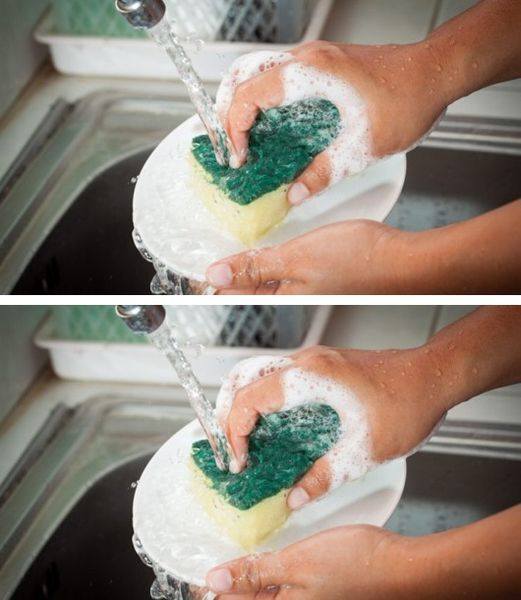ADVERTISEMENT
Dish Sponge: Expert Tips on How to Disinfect It and How Often You Should Replace It!
The humble dish sponge is a kitchen essential, tackling everything from greasy pots to sticky counter spills. However, while it may seem like a simple tool, your dish sponge can become a breeding ground for bacteria and germs, making it essential to properly disinfect it. In this article, we’ll explore expert tips on how to disinfect your dish sponge effectively and how often you should replace it to keep your kitchen clean and safe.
Why Should You Disinfect Your Dish Sponge?
A dish sponge may look innocent enough, but it’s a hot spot for bacteria. After all, sponges are constantly exposed to food particles, grease, and moisture, which provide an ideal environment for bacteria to thrive. Studies have shown that kitchen sponges can harbor a variety of harmful bacteria, including E. coli and Salmonella. Regularly disinfecting your dish sponge not only helps prevent the spread of germs but also prolongs the life of your sponge, keeping it fresh and effective for cleaning tasks.
How Often Should You Replace Your Dish Sponge?
While disinfecting your dish sponge regularly is important, it’s also crucial to know when it’s time to replace it. Even the best disinfecting methods can’t maintain a sponge’s effectiveness forever, and using a worn-out or fraying sponge can do more harm than good.
When to Replace Your Dish Sponge:
- Signs of Wear and Tear: If your sponge starts to fall apart, shed pieces, or develop holes, it’s time to replace it. A torn sponge can leave behind bits of sponge material that could scratch or damage your dishes.
- Lingering Odors: A sponge that consistently smells, even after disinfecting, may be harboring bacteria deep within the fibers. At this point, it’s time to say goodbye.
- Excessive Staining: If your sponge has accumulated stubborn stains that won’t come out, it might not be cleaning properly anymore, making it less effective.
- Frequency of Use: If you use your sponge daily, it’s a good idea to replace it every 2-4 weeks. For occasional use, you might be able to extend this timeframe, but regular inspection is key.
How to Disinfect Your Dish Sponge: Expert Tips
Disinfecting your dish sponge can be done in a variety of ways, and while some methods are more effective than others, all of them help reduce the bacterial load and keep your kitchen cleaner.
1. Microwave Method: Fast and Effective
The microwave method is one of the easiest and most effective ways to disinfect your sponge, as heat kills most bacteria and germs.
How to Do It:
- Dampen the Sponge: Before microwaving, make sure your sponge is damp. A dry sponge can catch fire in the microwave.
- Microwave on High: Place the damp sponge in the microwave and heat it on high for 1-2 minutes.
- Let It Cool: Carefully remove the sponge using tongs or an oven mitt (it will be hot). Allow it to cool before using.
Tip: This method works best for sponges without any metal components, like scrubbing pads with steel wool. Always check your sponge for any metallic parts before microwaving.
2. Dishwasher Method: Simple and Convenient
Your dishwasher is another great tool for disinfecting your sponge, especially when you’re running a load of dishes.
How to Do It:
- Place the Sponge in the Dishwasher: Place your dish sponge on the top rack of the dishwasher (it should be placed away from the heating element).
- Run a Hot Cycle: Run a hot water cycle to ensure your sponge gets sanitized properly. The high heat and detergent will kill most bacteria and germs.
Tip: You can also place multiple sponges in the dishwasher at once, making it a great method for keeping several sponges disinfected at the same time.
3. Bleach Solution: A Powerful Disinfectant
If you’re looking for a strong disinfecting method, bleach is a powerful option that will kill a wide range of bacteria.
How to Do It:
- Create a Bleach Solution: Mix 1 tablespoon of bleach with 1 cup of water in a bowl.
- Soak the Sponge: Submerge your sponge in the bleach solution for about 5 minutes.
- Rinse Thoroughly: After soaking, rinse the sponge thoroughly with clean water to remove any bleach residue.
Tip: Use this method sparingly, as bleach can break down sponges over time. Only use bleach if your sponge has serious contamination, like mold or unpleasant odors.
4. Vinegar and Baking Soda: Natural Disinfection
If you prefer a more natural approach, vinegar and baking soda can work wonders for sanitizing your sponge while also neutralizing odors.
For Complete Cooking STEPS Please Head On Over To Next Page Or Open button (>) and don’t forget to SHARE with your Facebook friends
